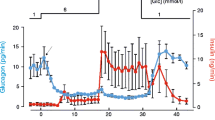Summary
Since it was unknown whether the uncharged or the anionic form of hypoglycemic sulfonylureas and meglitinide is the effective modulator of ATP-dependent K+ channels and insulin secretion, we studied the inhibitory effects of tolbutamide and meglitinide on the ATP-dependent K+ current at different external pH. The whole-cell configuration of the patch-clamp technique was used in mouse pancreatic B-cells. When the concentrations of the undissociated forms of these drugs were kept constant at increasing pH of the bath solution (6.4 to 8.4), the rate of development and the degree of K+ channel block varied only slightly. Raising the pH-value in the bath solution at constant total concentration of tolbutamide diminished both the rate of development and the degree of K+ channel block. It is concluded that the undissociated forms of tolbutamide and related compounds are the effective forms.
Examination of the K+ current records during the application and removal of different concentrations of tolbutamide, meglitinide, glipizide and glibenclamide at pH 7.4 indicated that the kinetics of the current records reflected not only association and dissociation of the drug-receptor complex but perhaps also the kinetic of drug distribution between bath and the lipid phase of the plasma membrane. As there is evidence against an interaction between sulfonylureas and their receptor via a binding site freely accessible from the cytoplasm, the drugs probably get access to their binding site on the receptor from the lipid phase of the B-cell plasma membrane.
Similar content being viewed by others
References
Fenwick EM, Marty A, Neher E (1982) A patch-clamp study of bovine chromaffin cells and of their sensitivity to acetylcholine. J Physiol 331:577–597
Findlay I, Dunne MJ (1986) ATP maintains ATP-inhibited K+-channels in a operational state. Pflugers Arch 407:238–240
Geisen K, Hübner M, Hitzel V, Hrstka VE, Pfaff W, Bosies E, Regitz G, Kühnle HF, Schmidt FH, Weyer R (1978) Acylaminoalkylsubstituierte Benzoe- und Phenylalkansäuren mit blutglukosesenkender Wirkung. Drug Res 28:1081–1083
Ginneken JM van (1977) Kinetics of drug-receptor interaction. In: Rossum JM van (ed) Kinetics of drug action, Handbook of experimental pharmacology, vol 47. Springer, Berlin Heidelberg New York Tokyo, pp 357–411
Gylfe E, Hellman B, Sehlin J, Täljedal I-B (1984) Interaction of sulfonylurea with the pancreatic B-cell. Experientia 40:1126–1134
Hamill OP, Marty A, Neher E, Sakmann B, Sigworth FJ (1981) Improved patch-clamp techniques for high-resolution current recording from cells and cell-free membrane patches. Pflügers Arch 391:85–100
Lernmark A (1974) The preparation of, and studies on, free cell suspensions from mouse pancreatic islets. Diabetologia 10: 431–438
Misler S, Falke LC, Gillis K, McDaniel ML (1986) A metabolite-regulated potassium channel in rat pancreatic B-cells. Proc Natl Acad Sci [USA] 83:7119–7123
Ohno-Shosaku T, Zünkler BJ, Trube G (1987) Dual effects of ATP on K+ currents of mouse pancreatic B-cells. Pflügers Arch 408:133–138
Panten U, Burgfeld J, Goerke F, Rennicke M, Schwanstecher M, Wallasch A, Zünkler BJ, Lenzen S (1989) Control of insulin secretion by sulfonylureas, meglitinide and diazoxide in relation to their binding to the sulfonylurea receptor in pancreatic islets. Biochem Pharmacol 38:1217–1229
Penner R, Pusch M, Neher E (1987) Washout phenomena in dialyzed mast cells allow discrimination of different steps in stimulus-secretion coupling. Bioscience Rep 7:313–321
Pusch M, Neher E (1988) Rates of diffusional exchange between small cells and a measuring patch pipette. Pflügers Arch 411:204–211
Rorsman P, Trube G (1985) Glucose-dependent K+-channels in pancreatic B-cells are regulated by intracellular ATP. Pflügers Arch 405:305–309
Rorsman P, Trube G (1986) Calcium and delayed potassium currents in mouse pancreatic B-cells under voltage-clamp conditions. J Physiol 374:531–550
Sturgess NC, Ashford MLJ; Cook DL, Hales CN (1985) The sulphonylurea receptor may be an ATP-sensitive potassium channel. Lancet 8453:474–475
Trube G, Rorsman P, Ohno-Shosaku T (1986) Opposite effects of tolbutamide and diazoxide on the ATP-dependent K+ channel in mouse pancreatic B-cells. Pflügers Arch 407:493–499
Zunkler BJ, Lenzen S, Männer K, Panten U, Trube G (1988) Concentration-dependent effects of tolbutamide, meglitinide, glipizide, glibenclamide and diazoxide on ATP-regulated K+ currents in pancreatic B-cells. Naunyn-Schmiedeberg's Arch Pharmacol 337:225 -230
Author information
Authors and Affiliations
Additional information
Send offprint requests to U. Panten at the above address
Rights and permissions
About this article
Cite this article
Zünkler, B.J., Trube, G. & Panten, U. How do sulfonylureas approach their receptor in the B-cell plasma membrane?. Naunyn-Schmiedeberg's Arch Pharmacol 340, 328–332 (1989). https://doi.org/10.1007/BF00168518
Received:
Accepted:
Issue Date:
DOI: https://doi.org/10.1007/BF00168518




